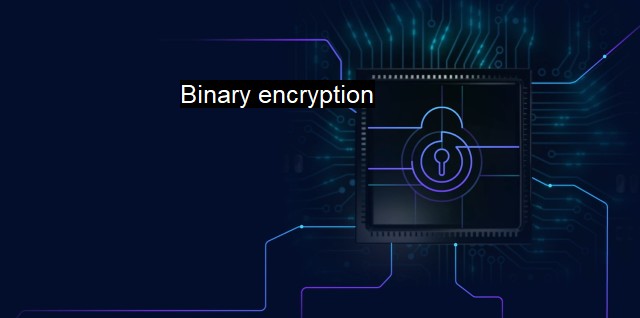What is Binary encryption?
Binary Encryption: Strengthening Online Security in the Digital World
Binary encryption is a significant aspect of cybersecurity, aptly purposed for data protection. It refers to a cryptographic process that converts data into binary codes — 0s and 1s — using algorithms and encryption keys. The encryption makes the data unreadable without the exact decryption key, ensuring the confidentiality, integrity, and security of the information. In a world where the digital revolution has intensified data breaches, binary encryption provides a formidable frontline defense, especially in securing sensitive information.Encryption isn't a novel concept; it dates back to ancient civilizations that utilized it in war. with the advent of computers and the internet, the science of cryptography has exponentially evolved. Enter binary encryption — a contemporary algorithmic methodology encrypts data in binary form, essentially transitioning plaintext into ciphertext. Plaintext refers to any readable data, while ciphertext is the encrypted form of that data. the word "hello" might cryptographically morph into "0110100001100101011011000110110001101111", for instance. This process conceals the plaintext's meaning, making it challenging to detect the original message without the decryption key.
The process of binary encryption inherently incorporates two essentials: the algorithm, which defines the steps or procedure of encryption, and the key, which is a sequence of bits used in the encryption or decryption algorithm. the algorithm details "how" to transition from plaintext to ciphertext or vice versa, and the key provides the counts. The encryption or decryption process might be ineffective if the key gets mishandled or misplaced.
There are two main types of binary encryption methods currently in use: symmetric and asymmetric encryption. In symmetric encryption, the same key is used for both the encryption and decryption processes. The key must be kept secret and shared only with the authorized parties involved. This method is quick but becomes impractical for massive data sets due to its single shared key. On the contrary, asymmetric encryption uses two different but mathematically related keys known as the public and private keys. The public key, as the name implies, can be commonly known and used for encryption, while the private key is kept confidential and used for decryption. It is slower and complex but provides supreme security for large data sets.
In matters regarding antivirus systems, knowing binary encryption is of immense importance due to its role in securing data. Antivirus software scans your files, identifying any potential threats, including executable code that may harm your computer or data. Binary encryption can prevent unauthorized access to these files, making them unreadable to hackers. the ubiquitousness of binary encryption in HTTPS protocols showcases its necessity in this digital era.
Binary files can be an attraction for viruses since they often contain executable instructions. Ransomware like GandCrab and Sodinokibi, which destroy or manipulate a victim’s machine/files unless a ransom gets paid, notably uses binary files. Binary encryption effectively safeguards against such dangerous scenarios.
Binary encryption plays an imperative role in upholding cybersecurity. In this increasingly digital era, where data breaches are ever prevalent, the protection of valuable information is paramount. Binary encryption methodologies and antivirus mechanisms work in tandem to ward off potential threats, thereby ensuring the safety of our data. Whether incorporated in the software development process or utilized in antivirus systems, understanding binary encryption is central in this age of advanced malicious cyber threats.

Binary encryption FAQs
What is binary encryption and how does it work in cybersecurity?
Binary encryption is a technique used in cybersecurity to secure data by encoding it into binary code, consisting of only 1s and 0s. This code is then transformed by an encryption algorithm to create a unique, secure representation of the data that can only be unlocked with a decryption key. This technique is commonly used to protect sensitive information such as passwords, financial data, and personal information.How does binary encryption differ from other encryption methods in antivirus protection?
Binary encryption is a subset of encryption techniques used in cybersecurity, which exclusively deals with binary code. This differs from other encryption methods that deal with different formats of data, such as text or images. In antivirus protection, binary encryption is used to secure critical data from unauthorized access or theft.Can binary encryption prevent malware attacks?
While binary encryption can make it difficult for attackers to access sensitive data, it is not a guaranteed defense against malware attacks. Malware can exploit vulnerabilities in systems or software and bypass encryption methods. However, using binary encryption can make it harder for hackers to extract sensitive data, thereby minimizing damage from an attack.What are the advantages of using binary encryption in antivirus software?
Binary encryption can provide several advantages in antivirus software, such as strong encryption for confidential data, protection against unauthorized access, and secure transmission of sensitive information. Furthermore, since binary code is universal across different computer platforms, binary encryption is a reliable technique that can be used across different operating systems and applications.| | A | | | B | | | C | | | D | | | E | | | F | | | G | | | H | | | I | | | J | | | K | | | L | | | M | |
| | N | | | O | | | P | | | Q | | | R | | | S | | | T | | | U | | | V | | | W | | | X | | | Y | | | Z | |
| | 1 | | | 2 | | | 3 | | | 4 | | | 7 | | | 8 | | |||||||